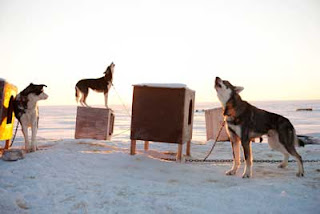
In the far north of Alaska, the fragile food web that supports polar bears and humans alike may be starting to unravel
On a Saturday morning in late November in Kotzebue, Alaska, a village 33 miles north of the Arctic Circle, two Inupiat men nursed cups of coffee at the Bayside Inn. They stared out a window at Kotzebue Sound, an arm of the Chukchi Sea at the southern edge of the Arctic Ocean. Outside it was 35 degrees and raining. "Too warm," said one of the men.
His companion let a long silence pass. Then he nodded. "Too much rain," he said. Indeed. In Kotzebue, November temperatures normally hover in the single digits. But these aren’t normal times. This is the time of "the changes" -- a term used by Caleb Pungowiyi, former president of the Inuit Circumpolar Council and one of Kotzebue’s most respected elders, when talking about the effects of climate change in the Alaskan Arctic. "Some events like this happen occasionally," Pungowiyi told me as we sat looking out at the rain. "But for something to happen that’s this warm, in November, for a number of days -- these kinds of temperatures are not normal. We should be down in the teens and minus temperatures this time of year."
A few days of rainy weather isn’t climate, but it is a powerful data point. You get enough warm, rainy days like this, and pretty soon they add up. This is how climate change happens in the far north: one warm rainy day at a time.
The thawing of the far north is one of the signal ecological events of our time. Global temperatures rose an average of 1.18 degrees Fahrenheit from 1905 to 2005, but that increase wasn’t evenly distributed. The Arctic took the brunt of it, warming nearly twice as fast as the rest of the planet. Since 1980, winter sea ice in the Arctic has lost almost half its thickness. In Kotzebue, the mean winter temperature has climbed more than 6 degrees in the past 50 years. Permafrost is thawing in patches all over the Arctic. "What we’re doing with climate change," says Brendan Kelly, a former University of Alaska biologist who is now deputy director of the National Science Foundation’s Arctic Sciences Division, "is carrying out a long-term scientific experiment at continental scale."
To get a sense of how that experiment is unfolding, it’s helpful to take a look at one of the most fundamental acts of life: eating, the passage of energy from one living organism to another. Predators and prey form a food chain, plant to insect to rodent to carnivore to apex predator. Those chains interlock to form webs. "To protect Nature," the conservation biologist Stuart Pimm wrote in his seminal book Food Webs, "we must have some understanding of her complexities, for which the food web is the basic description."...
Continue reading
Bruce Barcott @'onearth'










No comments:
Post a Comment